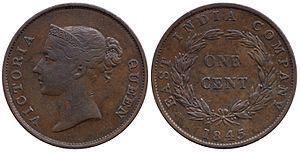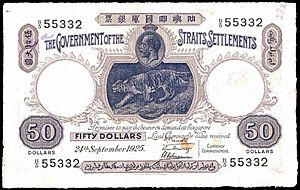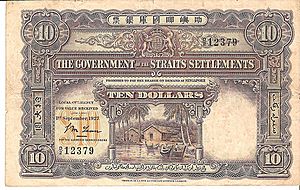Straits dollar facts for kids
The Straits dollar was the money used in the Straits Settlements from 1898 to 1939. It was also used in many other places nearby, like the Federated Malay States, Brunei, and British North Borneo. This currency helped people buy and sell things across a large part of Southeast Asia.
Contents
How the Straits Dollar Came to Be
Money Before the Straits Dollar
Long ago, in the early 1800s, the most common money in the East Indies was the Spanish dollar. These coins came from Spain and its colonies, like Mexico and Peru. Local areas also had their own coins, such as the Kelantan keping and the Penang dollar.
In 1826, the British formed the Straits Settlements. They tried to use the Indian rupee as the main money. However, the Mexican dollar was still better for trade. Private banks also printed their own paper money, which could be exchanged for silver dollars.
In 1844, copper coins were made for the Straits Settlements. These coins used a system where 100 cents equaled 1 dollar. This dollar was worth the same as the Spanish dollar. By 1867, the British took over the Straits Settlements, and the Indian rupee was no longer official money there.
Because there weren't enough Spanish silver dollars, the British started making their own trade dollars in 1895.
The Straits Dollar is Born
In 1897, a group called the Board of Commissioners of Currency was created. This board started printing official Straits Settlement money notes in 1899. Private banks were stopped from printing new banknotes.
In 1903, the board introduced the Straits dollar. It was worth the same as the British trade dollar. Other silver dollars, like the Mexican dollar, were no longer official money. By 1906, the Straits dollar was linked to the British pound sterling. This meant its value was set at two shillings and four pence.
In 1931, the British pound was no longer linked to gold. This changed how the Straits dollar's value was set, but it remained linked to the pound.
What Replaced the Straits Dollar?
The Straits dollar was replaced by the Malayan dollar in 1939. Both currencies had the same value at first.
Today, Brunei and Singapore still use currencies that came from the Malayan dollar. They have an agreement that lets people use both the Brunei dollar and the Singapore dollar in either country.
Coins of the Straits Dollar
The first coins for the Straits Settlements were made in 1845. They were copper coins in values of ¼, ½, and 1 cent. The British East India Company made them. You couldn't tell from the coins where they were supposed to be used.
In 1858, the British government took over the Straits Settlements. New coins were made in 1862 with "India – Straits" written on them.
Later, in 1871, silver coins were made for 5, 10, and 20 cents. Copper coins for ¼, ½, and 1 cent followed in 1872. Silver 50-cent coins came out in 1886. The first silver dollar coins were made in 1903.
On August 24, 1904, the Governor, Sir John Anderson, announced an important change. He said that by August 31, 1904, British, Mexican, and Hong Kong dollars would no longer be official money. They would be replaced by the new Straits Settlements Dollar.
This change helped the new Straits dollar have its own value, different from other silver dollars. When its value became stable, it was linked to the British pound.
A few years later, the price of silver went up a lot. This made the silver in the Straits dollar worth more than its official value. To stop people from melting down the coins for their silver, a new, smaller dollar coin was made in 1907 with less silver. The last ¼ cent coins were made in 1916. Dollar coins were last made for everyday use in 1926.
Banknotes of the Straits Dollar
The Board of Commissioners of Currency started printing paper money in 1898. They first made 5 and 10 dollar notes. Later, they added 50 and 100 dollar notes in 1901, and 1 dollar notes in 1906. During World War I, between 1917 and 1920, emergency 10 and 25 cent notes were printed. In the 1930s, only 1, 5, and 10 dollar notes were commonly used.
Early Government Banknotes (1899–1942)
Queen Victoria's Reign (1837–1901)
The Straits Settlements government was allowed to print money notes starting in 1898. These notes, dated September 1, 1898, were first given to the public on May 1, 1899. Even then, private banks like the Chartered Bank still printed their own notes, which were used alongside the official money. All notes could be freely exchanged for Mexican dollars or other silver coins.
King Edward VII's Reign (1901–1910)
When King Edward VII became king in 1901, the 5-dollar note was made smaller. This helped people tell it apart from the 10-dollar note. These notes were printed in London.
In 1903, a silver dollar coin was made especially for the Straits Settlements. This coin became the main unit of money. By 1904, all other silver dollars were no longer official money. However, the price of silver went up sharply. This meant the government had to replace the first Straits dollar coins with new ones that had less silver.
During this time, people worried there wouldn't be enough coins. So, the one-dollar paper note was introduced. Its value was set against gold, not silver. The British gold sovereign coin became official money, and the Straits dollar was set at two shillings and four pence sterling. This one-dollar note became very popular and was used instead of the silver coin.
By the end of 1906, a lot of government money was being used. The one-dollar notes, dated September 1, 1906, were also printed in London. The five-dollar and ten-dollar notes, dated June 8, 1909, were printed there too.
The banknotes had Chinese text at the top, which meant "banknote of the Straits Settlements." They also had Malay text at the bottom, which said that the government of Singapore, Penang, and Malacca promised to pay the value of the note.
King George V's Reign (1910–1936)
During King George V's time, even higher value notes were made, up to one thousand dollars. These were mainly used for large bank transfers. In 1915, the designs of the 50, 100, and 1000 dollar notes were completely changed. A 10,000 dollar note was also issued in 1922, but it was only used between banks, not by the public.
King Edward VIII's Reign (1936)
No special new notes were made during King Edward VIII's short time as king.
King George VI's Reign (1936–1952)
In 1933, a report suggested that a single currency board should manage money for all the Malay States and Brunei. This idea was accepted. New laws were passed in 1938 and 1939. This led to the Malayan dollar becoming the official money in the Straits Settlements and other areas.







